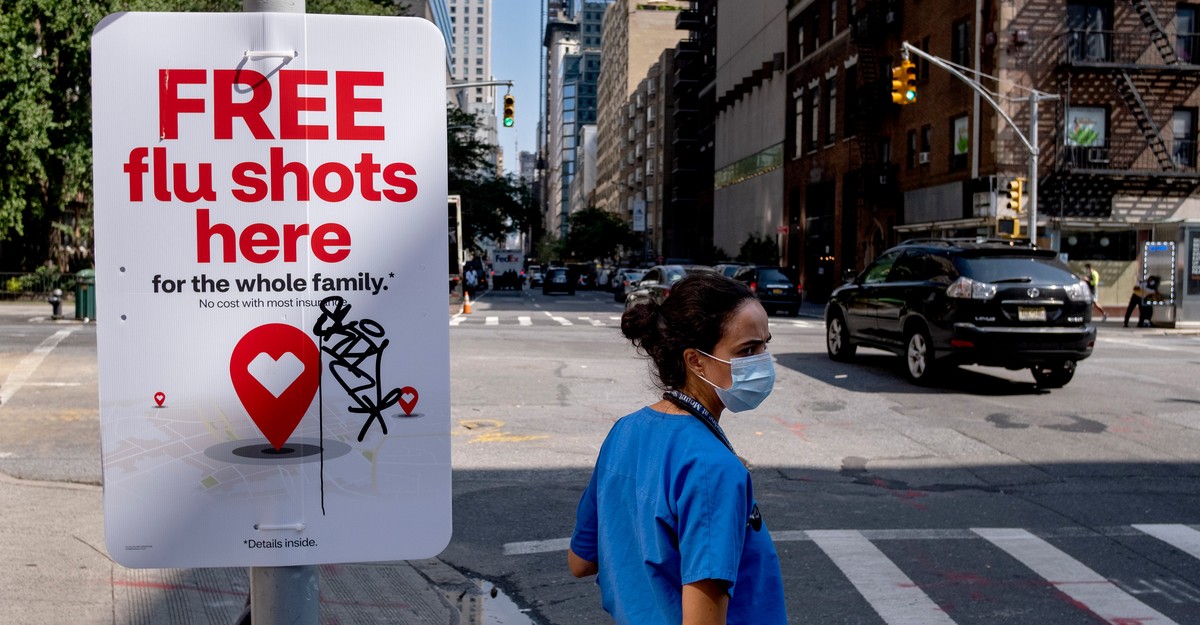For all the legwork that public-health experts have done over the past few years to quash comparisons between COVID-19 and the flu, there sure seems to be a lot of effort nowadays to equate the two. In an advisory meeting convened earlier today, the FDA signaled its intention to start doling out COVID vaccines just like flu shots: once a year in autumn, for just about everyone, ad infinitum. Whatever the brand, primary-series shots and boosters (which might no longer be called “boosters”) will guard against the same variants, making them interchangeable. Doses will no longer be counted numerically. “This will be a fundamental transition,” says Jason Schwartz, a vaccine policy expert at Yale—the biggest change to the COVID-vaccination regimen since it debuted.
Hints of the annual approach have been dropping, not so subtly, for years. Even in the spring of 2021, Pfizer’s CEO was floating the idea of yearly shots; Peter Marks, the director of the FDA’s Center for Biologics Evaluation and Research, teased it throughout 2022. This past September, Joe Biden officially endorsed it as “a new phase in our COVID-19 response,” and Ashish Jha, the White House’s COVID czar, memorably highlighted the convenience of combining a flu shot and a COVID shot into a single appointment: “I really believe this is why God gave us two arms.”
Still, in today’s meeting, FDA officials were pushier than ever in their advocacy for the flu-ification of COVID vaccines. “We think that simplification of the vaccination regimen would contribute to easier vaccine deployment, better communication, and improved vaccine coverage,” Jerry Weir, the FDA’s director of the division of viral products, said at the meeting. The timing is important: After renewing the U.S.’s pandemic-emergency declaration earlier this month, the Biden administration seems set to allow its expiration this coming April. That makes the present moment awfully convenient for repackaging a chaotic, crisis-caliber vaccination paradigm as a scheduled, seasonal, normal-seeming one. A once-a-year strategy, modeled on a routine recommendation, suggests that “we’re no longer in emergency mode,” says Maria Sundaram, a vaccine researcher at the Marshfield Clinic Research Institute. Or at least, that’s the message that the public is likely to hear.
But federal regulators may be trying to fit a COVID-shaped peg into a flu-shaped hole. The experts I spoke with largely agreed: Eventually, someday, annual autumn shots for COVID “will probably be sufficient,” says Gregory Poland, a vaccinologist at Mayo Clinic. “Are we ready for that yet? I’m not sure that’s the case at all.”
Even in the short term, COVID-vaccination tactics need a revamp. “It’s clear above all that the current approach isn’t working,” Schwartz told me. Despite abundant supply, demand for COVID boosters in the U.S. has been abysmal—and interest seems to be declining with each additional dose. Last fall’s bivalent shot has reached the arms of only 15 percent of Americans; even among adults over 65—a majority of whom sign up for flu shots each fall—the vaccination rate hasn’t yet reached 40 percent.
For most of the time that COVID shots have been around, figuring out when to get them has been a hassle, with different guidelines and requirements that depend on age, sex, risk factors, vaccination history, and more. Pharmacies have had to stock an absurd number of vials and syringes to accommodate the various combinations of brands and dose sizes; record-keeping on flimsy paper cards has been a total joke. “I do this for a living, and I can barely keep track,” Schwartz said. Recommendations on the proper timing and number of doses have also changed so many times that many Americans have simply checked out. After the bivalent recipe debuted, polls found that an alarming proportion of people didn’t even know the shot was available to them.
Streamlining COVID-vaccine recommendations will remove a lot of that headache, Sundaram told me. Most people would need to keep only one mantra in mind—one dose, each fall—and could top off their flu and COVID immunity at the same time. Burdens on pharmacies and clinics would be lower, and communication would be far easier—a change that could make an especially big difference for those with children, among whom COVID-vaccine uptake has been the lowest. “It’ll be more scheduled, more systematic,” says Charlotte Hobbs, a pediatric infectious-disease specialist at the University of Mississippi Medical Center. COVID shots could simply be offered at annual well-child visits, she told me. “It’s something we already know works well.”
The advantages of a flu-ified COVID shot aren’t just about convenience. If we have to shoehorn COVID vaccines into an existing paradigm, Sundaram told me, influenza’s is the best candidate. SARS-CoV-2, like the flu, is excellent at altering itself to dodge our defenses; it spreads readily in winter; and our immunity to infection tends to fade rather quickly. All of that adds up to a need for regularly updated shots. Such a system has been in place for decades for the flu: At the end of each winter, a panel of experts convenes to select the strains that should be targeted by the next formulation; manufacturers spend the next several months whipping up big batches in time for an autumn-ish rollout. The pipeline depends on a global surveillance system for flu viruses, as well as regular surveys of antibody levels in the community to suss out which strains people are still protected against. The premise has been so well vetted by now that researchers can skip the chore of running large-scale clinical trials to determine the efficacy and safety of each new, updated recipe.
But a seasonal strategy works best for a seasonal virus—and SARS-CoV-2 just isn’t there yet, says Hana El Sahly, an infectious-disease physician at Baylor College of Medicine. Though flu viruses tend to hop between the globe’s hemispheres, alternately troubling the north and the south during their respective cold months, this new coronavirus has yet to confine its spread to one part of the calendar. (Marks, of the FDA, tried to address this concern at today’s meeting, asserting that “we’re starting to see some seasonality” and that fall was indeed very sensible for an annual rollout.) SARS-CoV-2 has also been spitting out concerning variants and subvariants at a faster rate than the flu (and flu shots already have a hard time keeping up with evolution). The FDA’s new proposal suggests picking SARS-CoV-2 variants in June to have a vaccine ready by September, a shorter timeline than is used for flu. That still might not be fast enough: “By the time we detect a variant, it will have ripped through the global population and, in a few more weeks, died down,” El Sahly told me. The world got a preview of this problem with last year’s bivalent shot, which overlapped with the dominance of its target subvariants for only a couple of months. A flu model for COVID would make more sense “if we had stable, predictable dynamics,” says Avnika Amin, a vaccine epidemiologist at Emory University. “I don’t think we’re at that point.”
Murkiness around vaccine effectiveness makes this transition complicated too. Experts told me that it’s gotten much more difficult to tell how well our COVID vaccines are working, and for how long, fueling debates over how often they should be given and how often their composition should change. Many people have now been infected by the virus multiple times, which can muddy calculations of vaccine effectiveness; better treatments also alter risk profiles. And many researchers told me they’re concerned that the data shortcuts we use for flu—measures of antibodies as a proxy for immune protection—just won’t fly for COVID shots. “We need better clinical data,” El Sahly told me. In their absence, the hasty adoption of a flu framework could lead to our updating and distributing COVID shots too often, or not often enough.
A flu-ish approach also wouldn’t fix all of the COVID vaccines’ problems. Today’s discussion suggested that, even if a new COVID-shot strategy change goes through, officials will still need to recommend several different dose sizes for several different age groups—a more complex regimen than flu’s—and may advise additional injections for those at highest risk. At the same time, COVID shots would continue to be more of a target for misinformation campaigns than many other vaccines and, at least in the case of mRNA-based injections, more likely to cause annoying side effects. These issues and others have driven down interest—and simply pivoting to the flu paradigm “is not going to solve the uptake problem,” says Angela Shen, a vaccine-policy expert at Children’s Hospital of Philadelphia.
Perhaps the greatest risk of making COVID vaccines more like flu shots is that it could lead to more complacency. In making the influenza paradigm a model, we also threaten to make it a ceiling. Although flu shots are an essential, lifesaving public-health tool, they are by no means the best-performing vaccines in our roster. Their timeline is slow and inefficient; as a result, the formulations don’t always match circulating strains. Already, with COVID, the world has struggled to chase variants with vaccines that simply cannot keep up. If we move too quickly to the fine-but-flawed framework for flu, experts told me, it could disincentivize research into more durable, more variant-proof, less side-effect-causing COVID shots. Uptake of flu vaccines has never been stellar, either: Just half of Americans sign up for the shots each year—and despite years of valiant efforts, “we still haven’t figured out how to consistently improve that,” Amin told me.
Whenever the COVID-emergency declaration expires, vaccination will almost certainly have to change. Access to shots may be imperiled for tens of millions of uninsured Americans; local public-health departments may end up with even fewer resources for vaccine outreach. A flu model might offer some improvements over the status quo. But if the downsides outweigh the pluses, Poland told me, that could add to the erosion of public trust. Either way, it might warp attitudes toward this coronavirus in ways that can’t be reversed. At multiple points during today’s meeting, FDA officials emphasized that COVID is not the flu. They’re right: COVID is not the flu and never will be. But vaccines can sometimes become a lens through which we view the dangers they fight. By equating our frontline responses to these viruses, the U.S. risks sending the wrong message—that they carry equal threat.






